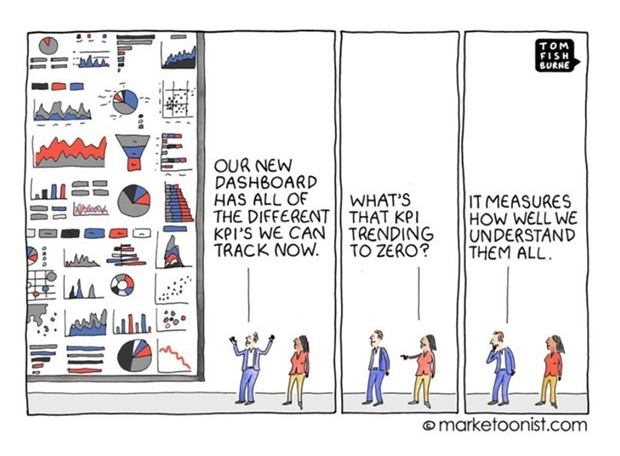Key Performance Indicators (KPIs) are more than just numbers; they’re the compass guiding your marketing efforts. But what happens when they’re pointing in the wrong direction? Misaligned KPIs can lead to decisions that feel right in the moment but ultimately block your growth.
This isn’t just theory—it’s a real-world challenge we’ve seen firsthand. In fact, one client’s reliance on the “right” KPI nearly brought their growth to a halt. Let’s unpack this story and how you can avoid the same mistake.

The Pitfall of Misaligned KPIs: A Story From the Field
Picture this: an ecommerce business, eager to grow, decides to set an ROI (Return on Investment) target of 3 for its marketing campaigns. The agency running the campaigns hits this target by focusing on brand traffic and existing customers—the low-hanging fruit that delivers quick returns. Success, right?
Not quite. By chasing this ROI target, the agency neglected new customer acquisition, the lifeblood of sustainable growth. Existing customers only carried the business so far before it hit a plateau. The KPI that looked so promising turned out to be the very thing holding them back.
The problem wasn’t the agency’s execution; it was the KPI itself. While the ROI target aligned with short-term financial objectives, it didn’t serve the broader business goal: sustained growth.
The Secret to the Right KPIs: Aligning With Your Business Goals
So, how do you set KPIs that drive long-term success? It starts with understanding the bigger picture. KPIs should bridge the gap between business goals and channel objectives.
For ecommerce growth, two key metrics come into play:
- Customer Lifetime Value (CLV): The total revenue you expect from a single customer over their entire relationship with your business.
- Customer Acquisition Cost (CAC): How much you can afford to spend to acquire a new customer while maintaining profitability.
When you know your CLV, you can reverse-engineer your CAC. This helps you set sustainable benchmarks for your acquisition campaigns, ensuring they bring in high-value customers at a cost that supports growth.
But here’s the catch: calculating CLV and CAC isn’t always straightforward. It demands clean, accurate data, a deep understanding of customer behavior, and the ability to predict future trends. While challenging, these metrics can become powerful tools for growth when approached with the right strategy. Should you need any help on defining these, we’d be more than happy to offer guidance to make the process clearer and more actionable.
Once your KPIs are aligned with your business goals, the next step is understanding how to apply them across your two key growth areas: acquisition and retention.
Acquisition and Retention: The Two Pillars of Growth
A growth-focused marketing strategy balances two objectives: bringing in new customers and maximizing the value of existing ones. Each requires distinct KPIs:
- Acquisition Campaigns: Cost Per Acquisition (CPA)
For acquisition campaigns, the focus should be on CPA. This KPI shows how efficiently your campaigns are converting prospects into paying customers. By comparing CPA to your CLV, you can ensure your acquisition efforts are sustainable and scalable.
- Retention Campaigns: ROI and Beyond
Retention campaigns aim to maximize the value of existing customers. ROI can be an effective KPI here, but it’s not the only metric to watch. Consider metrics like Average Order Value (AOV) or Repeat Purchase Rate (RPR) to measure your retention efforts.
It’s worth noting that retention doesn’t always require paid campaigns. Tools like email marketing, loyalty programs, and personalized upselling can help you engage customers without additional media spend. This frees up budget for customer acquisition, creating a balanced approach.
Turning Data Into Action: The Dashboard Solution
Even the best KPIs are only useful if you can track and act on them effectively. That’s where dashboards come in. A well-designed dashboard gives you a bird’s-eye view of your marketing efforts, consolidating metrics like CLV, CAC, CPA, and ROI into one place. It helps you make informed decisions quickly, spot opportunities, and address challenges.
Dashboards are particularly valuable because they integrate data from across your channels, ensuring every part of your strategy works in harmony. By presenting these insights visually, they make complex data easy to understand and actionable for both marketers and decision-makers.
Building such a dashboard might sound overwhelming, but it doesn’t have to be. Whether you’re just starting out or looking to enhance your existing tools, we’re here to help you create a solution tailored to your business needs. With the right dashboard, you’ll always have the insights you need at your fingertips.
Beyond ROI: Rethinking Your KPIs for Growth
Let’s return to the original mistake: relying on ROI as the sole KPI. While ROI is a valuable metric, it doesn’t tell the whole story. It focuses on efficiency, not growth. By prioritizing KPIs like CAC and CLV, businesses can develop strategies that balance acquisition and retention, driving sustainable growth over the long term.
Here’s the takeaway: your KPIs should serve your goals—not the other way around. They should empower you to make decisions that build your business, not just optimize individual campaigns.
Where Do You Start?
Setting the right KPIs can feel overwhelming, especially when it comes to calculating metrics like CLV and CAC or integrating them into a dashboard. But you don’t have to tackle it alone.
We’ve worked with ecommerce businesses to define their KPIs, align them with growth goals, and build dashboards that simplify decision-making. Growth doesn’t happen by accident—it’s a deliberate, strategic process. Let’s start by ensuring your KPIs are pointing in the right direction. Ready to take the next step? Reach out to start a conversation.
